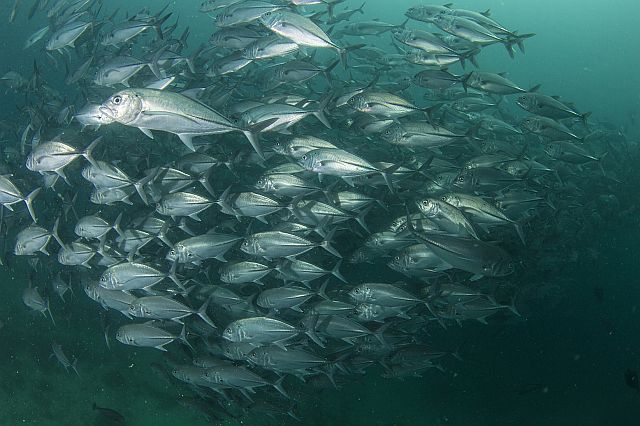Aquaculture: Future of fish harvest if …

A swirling ball of fish can be seen under 10 feet in the waters off Mactan Island in this Nov. 2016 photo. The aquaculture industry shows a lot of promise especially with the threat of depletion of the sea’s natural resources.
CDN FILE PHOTO
Huge potential is seen for agribusiness ventures, particularly in aquaculture, amid expectations of a stronger demand for food amid a growing population.
Maximo Richohermoso, chairman of the Seaweed Industry Association of the Philippines (SIAP), said aquaculture is “the future” of fish harvest due to depleting natural resources, but local players should address certain issues first before the sector can grow.
“We cannot just depend on natural harvest. The (natural) environment is sometimes not anymore conducive for growing (fish),” Ricohermoso said in a phone interview with Cebu Daily News.
Unity issues cited
He echoed Joseph Martin Borromeo, president of the Philippine Association of Fish Producers Inc. (PAFPI), who said in an Inquirer report last week that domestic players need to work on the unification of a fragmented industry, which he said has a “huge potential” to become a driver of economic growth.
The SIAP chairman said there used to be “strong” groups in the aquaculture sector, representing shrimp farmers and fish pond operators, among others.
He said other groups in the country have somehow disintegrated probably due to economic reasons or plainly because of non-cooperation among its members.
“Aside from uncooperative members, some Filipinos have that ‘to each his own’ attitude. There has to be a revival of these groups,” said Richohermoso.
Borromeo said that just like in the rest of Asia for the most part, aquaculture in the Philippines is a game where the players are small-scale that operate disparately.
He said that industry players had to consolidate and go for centrally managed operations.
Centrally managed ops
Richohermoso, for his part, said that centrally managed operations among players, whether big or small, would mean the produce is harvested and shipped to the market at the same time.
He said that not only would the smaller players included in the value chain, but consumers would also benefit since prices of goods would be expected to go down as well.
He also encouraged these aquaculture firms to also invest in good facilities for storage and shipping to ensure the quality of their products.
Dr. Allan Poquita, Bureau of Fisheries and Aquatic Resources Central Visayas (BFAR-7) OIC, agreed that there are bright prospects for the aquaculture sector if only their operations would be improved.
Poquita said the agency is also pushing for the growth of the sector, providing technical assistance to players, establishing post-harvest facilities, as well as implementing policies and guidelines to regulate the practice.
P300M budget
BFAR-7 has set aside a budget of P300 million for its operations in 2017, which includes an allotment for facilities and other infrastructure projects.
“Since aquaculture is done under controlled conditions, there is great potential in terms of (providing) the supply of food fish and other commodities,” he said.
Aside from consolidating what other stakeholders called a “fragmented” industry, the BFAR official said players should also comply with government regulations.
The PAFPI chief said the sector would be expected to be the biggest source of food fish since the output from wild capture fishing had reached a plateau.
Even so, he said the Philippines had dropped a notch to 11th worldwide in terms of fish production, with Myanmar dislodging the country from 10th place.
According to PAFPI, the Philippines produces 790,894 tons of fish products yearly, comprising 1.2 percent of global total.
Neighboring Vietnam, on the other hand, manages to haul 3.08 million tons or 4.6 percent of the total to rank third globally.
The total value of fisheries production amounted to P238 billion or $5.8 billion in 2015, more than 50 percent of which was generated through aquaculture.
Disclaimer: The comments uploaded on this site do not necessarily represent or reflect the views of management and owner of Cebudailynews. We reserve the right to exclude comments that we deem to be inconsistent with our editorial standards.
